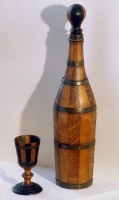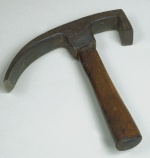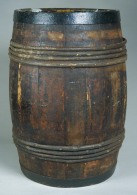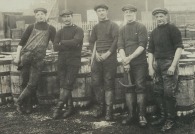Herring Home | Sale and Processing of the Herring | Back to Filling barrels and Inspection
Barrel Making

The craft of barrel making, or cooperage, was an essential part of the fishing industry. Many coopers were required to produce enough barrels for the herring trade. Cooperage was therefore one of the biggest industries in the fishing towns. It was highly skilled work with the coopers having to serve a long apprenticeship. At the end of this time they were required to make apprentice pieces to prove their abilities. A skilled cooper could make 70 barrels in a week.

Barrels were generally made of wood imported from Scandinavia, usually spruce, although in earlier times local larch and birch wood was used. The wood had to be dry and heavy. The staves of the barrel had to be cut and planed to exactly half an inch thick. If the joints were not straight they would not fit closely together and the barrel might leak. The staves were held together by wooden hoops and were moistened inside with water and heated until the cooper judged them the right temperature to bend into shape. An adze was then used to cut the rim or 'chime' of the barrel. Once the rim had been cut, a special tool called a croze was used to make the groove in the lid. The 'head' or lid was then fitted on using a chive and flencher.

Strict regulations covered the making of barrels and their use in the fishing industry. In 1815 it was ruled that barrels staves had to be exactly half an inch thick, and the exact number of hoops to be used. If the barrels did not meet the requirement, pickle could leak out or air could get in, which would contaminate the fish and spoil the cure. To stop the use of undersized barrels, a standard capacity of 32 gallons for a barrel was introduced. A full barrel held a cran of herring (a volume measure of around 1000 fish). The cooper worked closely with the curer to ensure his barrels met with these regulations and were watertight.

At the beginning of the 20th century the task of barrel making began to be mechanised. By 1907, there were 7 factories in operation.
Herring Home | Sale and Processing of the Herring | Back to Filling barrels and Inspection